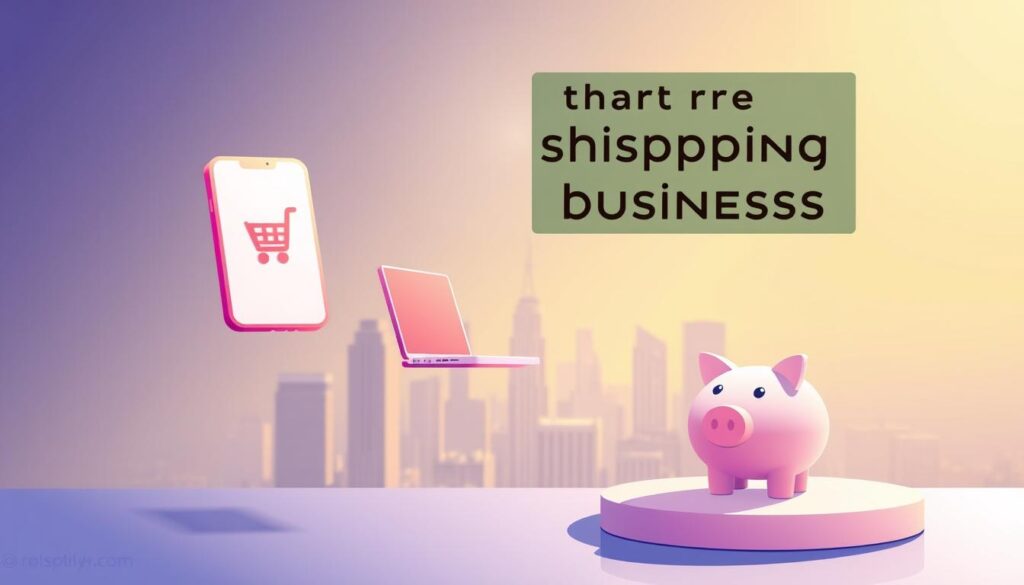The e-commerce world is evolving fast, and dropshipping business models are leading the charge. With no need for upfront investment in inventory, this approach lets you focus on selling trending products without the hassle of storage or shipping.
Social commerce and AI tools are making it easier than ever to start dropshipping. Platforms like TikTok Shop and Facebook Marketplace offer organic traffic opportunities, while tools like AutoDS simplify order management. Free research methods, such as Google Trends, help identify winning products.
Shopify and similar platforms enable quick store setups with minimal costs. The future of e-commerce is here—lean, automated, and full of potential.
Key Takeaways
- No upfront costs make dropshipping an accessible business model.
- Social commerce platforms like TikTok Shop boost visibility.
- AI tools streamline operations for efficiency.
- Free research methods help find profitable products.
- Shopify enables fast, low-cost store creation.
What Is Dropshipping and How Does It Work?
Modern entrepreneurs can now run stores without handling physical inventory. This model connects you with suppliers who ship products directly to customers. You only pay for items after they’re sold, keeping profit margins flexible.
The Basics of the Dropshipping Model
Suppliers handle storage, packaging, and shipping. Your role? Market products and manage customer relationships. No upfront investment in stock means minimal financial risk.
Popular platforms like Shopify offer free trials to launch your store fast. Their apps automate order forwarding to suppliers, streamlining operations.
Why Dropshipping Is Ideal for Low-Budget Entrepreneurs
Traditional businesses require renting space and buying inventory. With dropshipping, your costs are limited to marketing and website fees. Here’s a breakdown:
| Expense | Traditional Store | Dropshipping |
|---|---|---|
| Inventory | $5,000+ | $0 |
| Warehouse | $1,500/month | $0 |
| Shipping | $2–$10 per order | Supplier covers |
Free traffic sources like TikTok organic posts can kickstart sales. Leverage trends to find winning products without ads.
How to Start a Dropshipping Business in 2025 ($0 Investment)
Breaking into e-commerce without upfront costs is now a reality. Follow this step guide to get started fast and lean.

First, validate demand using free tools like TikTok trends or Google Trends. Look for items with rising searches but low competition. This ensures your products sell effortlessly.
Next, partner with suppliers offering dropshipping. Platforms like AliExpress or Spocket let you negotiate terms. Aim for discounts on bulk orders—even if you’re not holding stock.
Use Shopify’s free trial to build your store. Customize a template, add products, and connect payment gateways. AutoDS’s free plan automates order forwarding, saving hours.
Leverage social media to test products. Post organic content about your picks. If engagement spikes, you’ve found a winner—*no ads needed*.
Virtual credit cards (like Privacy.com) help manage supplier payments securely. They prevent overcharges and simplify budgeting.
Finally, scale by reinvesting profit. Upgrade tools or run targeted ads once sales stabilize. This business model grows with your success.
Finding Winning Products Without Spending a Dime
Discovering hot-selling items doesn’t require deep pockets—just smart research. Free tools and social media platforms reveal what’s trending before competitors catch on. Here’s how to spot gems without a budget.
Free Product Research Tools and Methods
TikTok Creative Center shows viral videos and rising hashtags. Filter by niche to see what’s gaining traction. For example, LED dog collars exploded after pet influencers showcased them.
Instagram’s hashtag tracking reveals what your audience loves. Tools like Brand24 monitor mentions in real time. Spot patterns—like sudden spikes in eco-friendly kitchenware—to capitalize early.
| Tool | What It Tracks | Best For |
|---|---|---|
| TikTok Creative Center | Viral videos, hashtags | Short-term trends |
| Google Trends | Search volume history | Seasonal demand |
| Reddit Keyword Monitor | Subreddit discussions | Niche market gaps |
Leveraging Social Media Trends for Product Ideas
Reddit’s r/Entrepreneur shares firsthand success stories. A user recently profited from reusable straws after noticing complaints about plastic waste. Dive into comments for unmet needs.
Pro Tip: Combine TikTok’s trend data with Google Trends’ longevity metrics. If a product spikes on both, it’s likely a winner. Test small batches before scaling.
Choosing the Right Dropshipping Suppliers
Your supplier choice makes or breaks your e-commerce success. They handle inventory, shipping, and returns—so picking the wrong one risks delays, poor quality, or lost customers. Focus on reliable partners who align with your brand’s needs.

Key Traits of a Reliable Supplier
Look for fast shipping times (under 10 days). Delays frustrate buyers and hurt reviews. Check supplier ratings on platforms like AliExpress—4.5+ stars is ideal.
Clear communication matters. Test response times before committing. Ask about bulk discounts or white-label options if scaling.
*Pro Tip*: Order a sample to check quality. A $5 test saves hundreds in refunds later.
Top Free Supplier Platforms to Consider
AliExpress integrates with DSers for automated orders. It’s beginner-friendly but has longer shipping. For US fulfillment, try SaleYee—3–5 day delivery.
AutoDS Warehouse offers white-label products. Custom packaging builds brand trust without upfront costs.
TikTok Shop suppliers require fast processing. Verify their return policies match your store’s standards.
Beware of fake supplier sites. Red flags include:
- No customer reviews or contact info.
- Prices far below market rates.
- Vague shipping policies.
Use tools like Supplier Blacklist databases to avoid scams.
Setting Up Your Dropshipping Store for Free
Free platforms let you create a professional store in minutes. Whether you choose a customizable website or a marketplace, each option has unique perks. Focus on ease of use, scalability, and integration with suppliers.
Customizable Websites vs. Marketplaces
Standalone websites (like Shopify) offer branding control. Marketplaces (e.g., Etsy) provide built-in traffic but higher fees. Here’s a quick comparison:
| Feature | Customizable Websites | Marketplaces |
|---|---|---|
| Cost | Free trials, then $29+/month | Listing fees + commission |
| Branding | Full customization | Limited to marketplace rules |
| Traffic | Requires marketing | Built-in audience |
Step-by-Step Store Creation
Follow this step guide to launch on popular platforms:
- Shopify: Use its free trial and AI-powered product descriptions (Shopify Magic).
- Wix: Leverage ADI for automated design—just answer a few questions.
- WooCommerce: Install the free plugin on WordPress for full flexibility.
Essential free tools include:
- Legal page generators (e.g., LawDepot) for terms and policies.
- Oberlo for product imports (Shopify only).
- Canva for quick logo and banner designs.
Pro Tip: Test multiple platforms during free trials to find your fit. Your store’s foundation impacts long-term growth.
Marketing Your Store on a $0 Budget
Growing your online store doesn’t require a hefty ad budget—just smart tactics. Focus on organic reach and free tools to attract buyers. Here’s how to maximize visibility without spending.

Organic Social Media Strategies
Platforms like TikTok and Instagram reward engaging content. Post short videos showcasing your products in action. Use trending sounds and hashtags to boost discoverability.
*Pro Tip*: Partner with nano-influencers (1K–10K followers). They often promote for free samples or affiliate deals.
| Platform | Best Content Type | Engagement Hack |
|---|---|---|
| TikTok | Demo videos | Use trending hashtags |
| Carousel posts | Tag suppliers | |
| Infographics | Keyword-rich pins |
SEO Tips to Drive Free Traffic
Optimize product listings with tools like Keywords Everywhere. Include long-tail phrases (e.g., “eco-friendly yoga mats for beginners”) in titles and descriptions.
Boost SEO further with these free tactics:
- Add alt-text to images (e.g., “blue LED dog collar”).
- Use schema markup generators for rich snippets.
- Integrate Google Business Profile for local searches.
YouTube unboxing videos rank well. Keep titles under 60 characters and include your target keyword.
Fulfilling Orders Efficiently Without Inventory
Smooth order fulfillment keeps customers happy and boosts repeat sales. Since suppliers handle shipping, your job is to ensure seamless tracking and communication. Tools like AutoDS automate the process, forwarding orders instantly.
Handling Supplier Errors Gracefully
Mistakes happen—delays, wrong items, or lost packages. Protect your customer service reputation by:
- Setting clear expectations upfront (e.g., “Ships in 3–5 days”).
- Offering discounts or freebies for inconveniences.
- Using backup suppliers for high-demand products.
| Common Issue | Quick Fix |
|---|---|
| Late shipping | Provide a tracking link and update buyers daily |
| Wrong item sent | Send correct product + let them keep the mistake |
Free Tools to Streamline Operations
Leverage these tools to save time:
- AutoDS: Tracks orders and syncs tracking numbers automatically.
- ReturnLogic: Manages returns without coding (free tier available).
- SimplyDuty: Calculates customs fees for international buyers.
Pro Tip: Slip branded thank-you notes into packages. A personal touch upsells future purchases.
Automating Your Dropshipping Business
Automation transforms time-consuming tasks into effortless processes. With the right tools like AutoDS or Zapier, you can manage pricing, orders, and customer service on autopilot. This saves hours weekly and boosts profit margins by reducing errors.
Must-Have Free and Low-Cost Automation Tools
AutoDS handles stock monitoring and order fulfillment. Set price rules to adjust margins dynamically. Its free tier covers basics, while paid plans unlock bulk edits.
*Pro Tip*: Use Zapier’s free tier to connect Shopify with Gmail or Slack. Automate notifications for new orders or low inventory.
- Canva: Batch-edit product images for consistency.
- ChatGPT: Generate FAQ responses or email templates instantly.
- InventoryYak: Get real-time stock alerts to avoid overselling.
These tools like AutoDS integrate seamlessly with major platforms. Focus on scaling while they handle the grunt work.
Scaling Your Dropshipping Business in 2025
Growing your e-commerce venture requires smart scaling strategies. Whether you choose vertical or horizontal expansion, each approach impacts your profit margins differently. Vertical scaling means selling more to existing customers, while horizontal scaling taps new market segments.
AutoDS Hand-Picked Products Hub simplifies finding high-margin items for growth. Their curated selections help boost average order values without extra research.
| Scaling Type | Best For | Risk Level |
|---|---|---|
| Vertical | Upselling bundles/subscriptions | Low |
| Horizontal | Entering new niches | Medium |
Diversify suppliers to protect your business from stockouts. Work with 3-5 verified partners for popular products. This ensures continuity when one supplier faces delays.
«Dynamic pricing tools adjust costs based on demand—increases profit by 12-18% during peak seasons.»
Micro-influencers (10K-50K followers) drive authentic sales. Offer them commission-based partnerships instead of flat fees. Their engaged audiences convert better than celebrity endorsements.
- Track competitor pricing with AI tools like RepricerExpress
- Create exit strategies early—document processes for potential buyers
- Use heatmaps to identify underperforming market segments
Remember: Sustainable growth beats rapid expansion. Test new strategies with 20% of your sales budget before full implementation. Your business thrives when scaling aligns with customer demand.
Success Stories: Dropshipping with $0 Investment
Real entrepreneurs prove that launching a thriving online store without upfront costs is possible. These case studies reveal how smart strategies turn minimal efforts into impressive sales. Learn from their wins and avoid common pitfalls.
John Murphy scaled his ebike hunting gear store to $3M annually. He tapped into a niche market using TikTok organic traffic. His secret? Focusing on high-quality products with passionate audiences.
| Case Study | Strategy | Time to $10K/Month |
|---|---|---|
| AutoDS User | Automated order fulfillment | 4 months |
| Pet Tech Store | Leveraging nano-influencers | 6 months |
| Eco-Friendly Home Goods | SEO-driven blog content | 5 months |
One AutoDS user hit $10K/month by reinvesting early profit into targeted ads. They tested 20 products first, then doubled down on the top three performers. This lean approach minimized risk.
Another success story comes from a pet tech store. They dominated their niche by:
- Partnering with micro-influencers for authentic reviews
- Using Google Trends to spot rising demand for GPS collars
- Offering bundle deals to boost average order value
«Reinvesting 70% of profits back into marketing fueled our growth. Within six months, we scaled from $2K to $50K monthly.»
These examples show that starting with zero capital isn’t a barrier. The right products, combined with organic marketing, create sustainable revenue streams. Your journey begins with one tested winner.
FAQ
Can I really start a dropshipping business with no money?
Yes! Platforms like Shopify, Wix, and WooCommerce offer free trials. You can also use free marketing methods like social media and SEO to drive traffic without spending on ads.
How do I find trending product without paying for research tools?
Use free tools like Google Trends or TikTok’s Discover page. Look for viral products on Instagram Reels and Pinterest. Analyzing competitors’ bestsellers also helps.
What’s the best way to choose a reliable supplier?
Check reviews, response times, and shipping policies. Platforms like AliExpress and Spocket offer vetted suppliers. Always order samples to test quality.
Conclusion
The future of e-commerce is lean, automated, and full of potential—your journey starts now. Social commerce and AI tools level the playing field, letting you compete without upfront costs.
Follow this guide to launch strong:
- Test products with free tools like TikTok Trends.
- Partner with reliable suppliers for fast shipping.
- Automate orders to save time and scale faster.
Stay curious. Reinvest early profit into what works. Free courses (like AutoDS Academy) deepen your skills.



